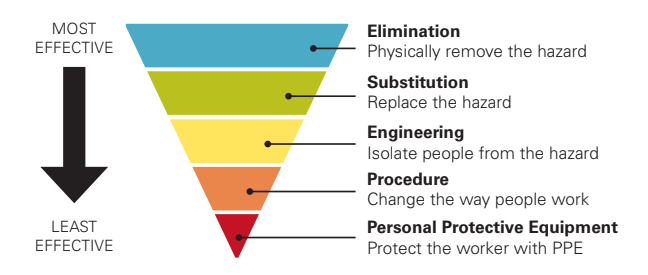FACILITIESSAFETY
The Facilities Division provides a variety of services directed to create and preserve the physical environment that advances the university. Facilities employees must complete each and every task with their personal safety and the safety of their co-workers at the front of every decision. A safe workforce is a productive workforce.
It is NC State University’s environmental health and safety policy that no job is so important and no service so urgent, that we cannot take the time to perform our work safely, and in an environmentally conscientious manner.
The Facilities Division’s safety mission is No One Gets Hurt: Go For Zero. The purpose is for all Facilities Division employees to make safety personal, be able to purposefully identify hazards and establish control methods to address these hazards.
Field Guide
The most important safety info — all in one place
Daily Safety Briefing
Your pre-work safety briefing; please note this is required during adverse weather conditions
Training
Access safety training resources including the Safety Training Plan
Hazard ID and Mitigation
Facilities Division employees use the following process prior to each job task:
- Identify Hazards
- Assess Hazards
- Establish Controls using the Hierarchy of Controls
- Monitor Effectiveness
If a hazard is not controlled, every individual employee is empowered and expected to PAUSE the activity until action is taken to control the hazard.

| Category | Hazard Examples | Control Examples |
| Slips, Trips, Falls | Fall from height Slippery surfaces Objects in a walkway Changes in elevation | Guardrail Fall protection Barricading slippery area Good housekeeping |
| Electrical | Exposed energized parts Damaged cords Power lines (over/under) Arc Flash | De-energize, test, Lock Out Tag Out Inspect cords (remove/repair) Maintain safe distances Ground Fault Circuit Interrupter |
| Pressure | Steam and Condensate Lines Hydraulic Equipment Residual Energy Compressed Gases and Lines | Preventative Maintenance Inspection Lock Out Tag Out Cable Check (whip check) |
| Mechanical | Rotating Equipment Pinch Points Missing Guards Component Failure | Installing Barriers Installing Guards Lock Out Tag Out Preventative Maintenance |
| Vehicle | Backing (obstructed view) Speed Restricted view Distractions | Cameras Back up alarms/spotters High Visibility lights / PPE No portable electronic device use |
| Temperature | Outdoor temperatures Ambient temperatures Hot Work (welding/torch/etc.) Hot | Cold surfaces | Heat illness prevention program Hot work permits Signs PPE |
| Chemical | Toxicity Flammability Reactivity Other hazards | Ventilation Proper use and storage Training PPE |
| Health | Silica, Asbestos, Lead Noise Biological Radiation Welding | Abatement (removal) Ventilation / vacuum Work Practice Barriers Personal Protective Equipment |
| Ergonomics | Excessive force Repetitive motion Awkward posture | Right tool for job Work / Rest cycles Mechanical vs manual Proper lifting |
| Struck By or Against | Falling objects Flying objects Limited space for work Excavation cave-in | Secure objects Barricades Install bump protection Cave-in protection |
Resources
Safety Action Committee
The purpose of the Safety Action Committee is to establish and sustain an effective safety culture. The goal of the Safety Action Committee is to ensure that facilities employees at all levels within the division are active participants in the facilities safety program, thereby positively affecting the safety culture. Employees are encouraged to contact committee members submit questions, comments, ideas or concerns.

